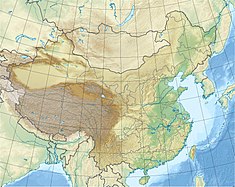
Back Brana Baihetan BS Baihetan-Talsperre German Presa de Baihetan Spanish سد بایهتان Persian Barrage de Baihetan French סכר באיחטאן HE بایهتان سد MZN Baihetan-demningen NB Usina Hidroelétrica de Baihetan Portuguese ГЭС Байхэтань Russian
| Baihetan Dam | |
|---|---|
| Official name | 白鹤滩大坝 |
| Coordinates | 27°13′07″N 102°54′22″E / 27.21861°N 102.90611°E |
| Construction began | 2017 |
| Opening date | February 2021 |
| Construction cost | ¥220 billion (US$31.58 billion)[1] |
| Dam and spillways | |
| Type of dam | double-curvature arch dam |
| Impounds | Jinsha River |
| Height | 289 metres (948 ft)[2] |
| Width (crest) | 13 metres (43 ft) |
| Width (base) | 72 metres (236 ft) |
| Reservoir | |
| Total capacity | 17,924,000,000 m3 (14,531,223 acre⋅ft)[3] |
| Power Station | |
| Turbines | 16 × 1 GW |
| Installed capacity | 16 GW (operational) |
| Annual generation | 60.24 TWh[4] |
The Baihetan Dam (simplified Chinese: 白鹤滩大坝; traditional Chinese: 白鶴灘大壩; pinyin: Báihètān Dàbà) is a large hydroelectric dam on the Jinsha River, an upper stretch of the Yangtze River in Sichuan and Yunnan provinces, in southwest China. The dam is a 289-meter-tall double-curvature arch dam with a crest elevation of 827 m, and a width of 72 m at the base and 13 m at the crest.[4] It is considered to be the last large hydropower project in China after a series of projects starting with the Three Gorges Dam.[5] It is also the second largest hydropower plant in the world. The hydropower station is equipped with 16 hydro-generating units each having a capacity of 1 billion Watts, the world's largest turbines.[6] All hydro-generating units of the Baihetan hydropower station became fully operational on 20 December 2022.[7]
The dam is also part of the “world’s largest clean energy corridor”, where it joins other mega hydropower projects like the Three Gorges Dam, Wudongde Dam, Xiluodu Dam, and Xiangjiaba Dam, all located on the same river system, to produce and transmit renewable energy from the resource-rich western region to the cities in the east.[8][6] In addition to power generation, the hydropower project also provides flood control, improved navigation, and sand blocking.[9]
- ^ Xie, Echo (28 June 2021). "China turns on world's first giant hydropower turbines". South China Morning Post. Retrieved 6 July 2021.
- ^ "Baihetan Hydropower Project, China - World's second biggest power plant".
- ^ "Baihetan Hydropower" (in Chinese). Baihetan. Archived from the original on 19 April 2014. Retrieved 23 August 2011.
- ^ a b Cite error: The named reference
cwewas invoked but never defined (see the help page). - ^ "China's Era of Mega-Dams Is Ending as Solar and Wind Power Rise". Bloomberg.com. 2020-07-03. Retrieved 2021-04-09.
- ^ a b "China builds world's largest clean energy corridor". Azernews.Az. 2022-12-20. Retrieved 2022-12-21.
- ^ Cite error: The named reference
:4was invoked but never defined (see the help page). - ^ "How China is leading the world in clean energy". The CEO Magazine. Retrieved 2022-12-23.
- ^ reduper (13 September 2022). "Baihetan Dam". Super Engineering Website. Retrieved 2022-12-21.
